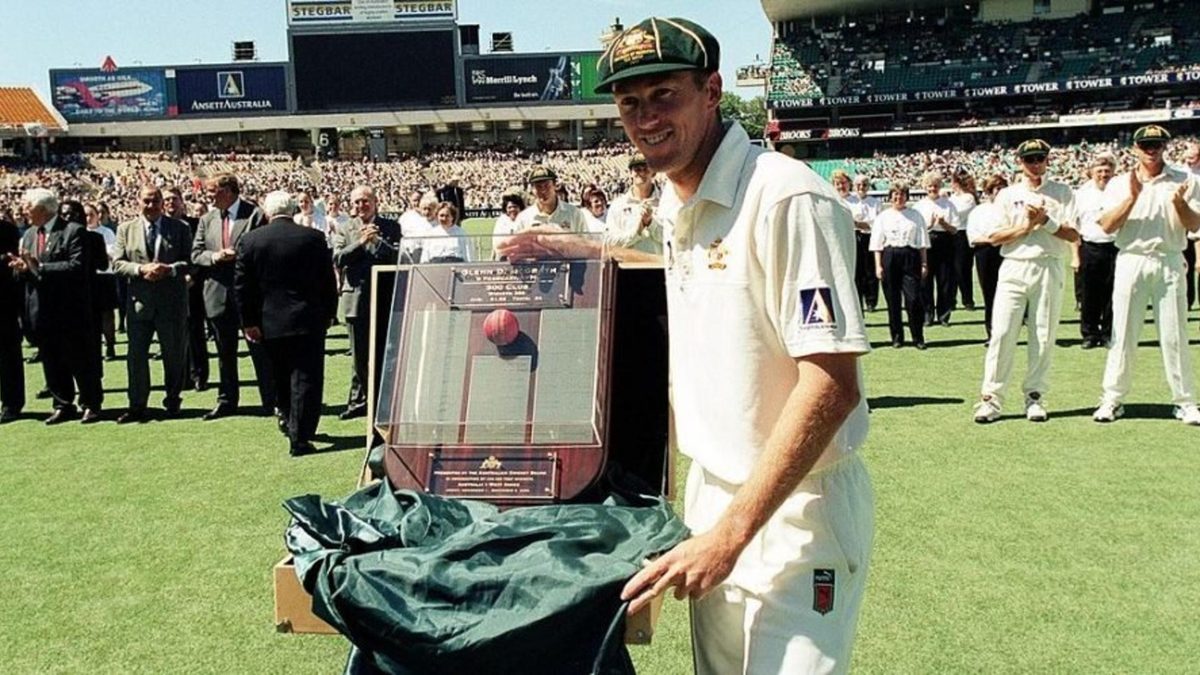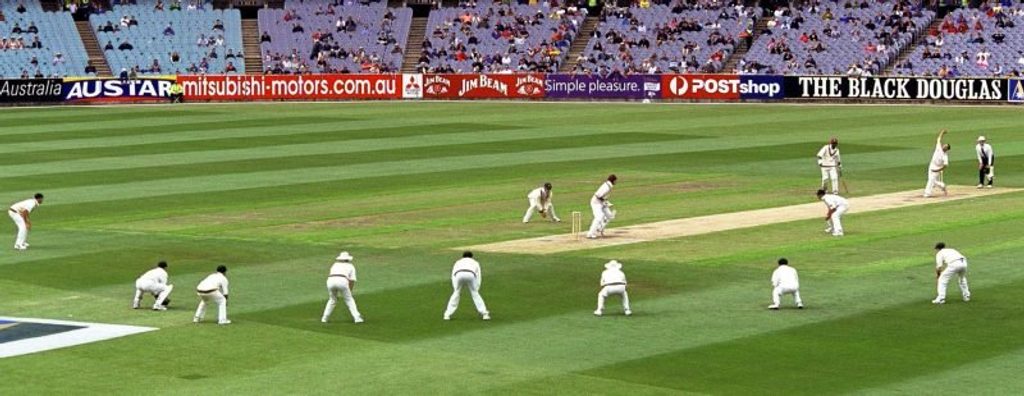
With West Indies’ 2000/01 tour of Australia went the last link to their golden era. Geoff Lemon remembers blue hair, outrageous fields and Glenn McGrath at his most majestic.
Published in 2015
Published in 2015
It’s a bright Australian afternoon, one of the last glowing embers of the year 2000. Jarvis Cocker has four days left to arrange a meeting with Deborah. Stanley Kubrick’s spacecraft has 12 months to launch, and his isn’t the only sci-fi title on the brink of anachronism. The day after Boxing Day, Australia’s mediocre batting has been saved by Steve Waugh’s century. West Indies walk out to reply.
The protagonists come in pairs. Sherwin Campbell and Daren Ganga. Glenn McGrath and Jason Gillespie. How the latter have tormented the former. This opening pair will never see another Test match, after eight innings averaging 10.06 runs each and 13.25 in partnership. Theirs is a microcosm of their team’s struggle: over the preceding month West Indies have not only been taken apart, but stacked by the roadside and hauled off to the tip.
Campbell and Ganga cross the expanse of green, crowd poised to relish their failure. Fifteen years later, New Zealand will joke before a World Cup final that the MCG is so big that they’ll get lost trying to find the pitch. On this day it looks that way – the batsmen hunched into tininess, Rick Moranis characters on a billiard table. The bowlers prance with equine assurance, high-stepping and mane-tossing. The field is set.
Slip. Slip. Slip. Slip. Slip. Gully. Gully. Even seamer Andy Bichel is in the cordon. Now a short-leg, for the ball into the ribs: Justin Langer a metre from the batsman. Eight of nine available fieldsmen await a catch.
The only man not awaiting a catch is fine-leg, keeping the bouncer in play. The only man in front of the wicket is nobody. Melbourne’s turf is a field of dreams. The merest defensive push will get you runs. For seven overs, Campbell and Ganga do not score.
They flinch. They jump. They prod with bats angled and wrists askew. They leave innocuous ones, or bunt returns to sender. They are nerve bundles, jangling like a janitor’s keys. They would have to join a marching band to spell this out any more blatantly. The bowlers groove a channel outside off. Each ball you hold your breath. The spell does not break. The batsmen are hypnotised. I will watch many better contests, but this will remain the most technically compelling passage of Test cricket I’ve seen.
[caption id=”attachment_184120″ align=”alignnone” width=”800″] The most outrageous field-setting
The most outrageous field-setting
[/caption]
***
I didn’t know you were supposed to be afraid of the West Indies. As a television-minimal child of the 1980s, the Caribbean reign of joyful terror passed me by. So by 2000 I was able to feel sorry for them. The production line from Holding to Marshall to Ambrose had given way to Merv Dillon, Nixon McLean, Colin Stuart, Marlon Black. The batting was worse. State sides cleaned them up in tour games. Australia’s top three bowlers took 61 wickets at 17.90. I revelled in West Indies’ smallest victories. It was a hammering, but god it was fun to watch.
Australia wore the Ansett logo, shortly before the airline’s final landing. With an injured Shane Warne in the commentary box, McGrath got 11-27 in Brisbane, on a hat-trick twice before converting in Perth, where Brett Lee ran five through the tail. Colin Miller got 10 for the match in Adelaide, Andy Bichel his maiden five-fer in Melbourne, where Gillespie had them 23-6 in the second. Stuart MacGill got seven in Sydney. Lower-order romps were in vogue, Adam Gilchrist often batting eight because of nightwatchmen. Lee and MacGill put on 50 in Brisbane and 48 unbeaten in Perth: 10.6 per cent of the leggie’s career runs came in those knocks.
Miller, a club seamer turned offie, would soon be Australia’s Test Player of the Year. He batted below MacGill in Adelaide and by Melbourne was pinch-hitting at six. I walked into the ground the second day to the roar of his hook over long-leg. Then emerging in Sydney with his hair dyed a peacock blue that sparkled in the sunlight, soon to become a sweat river down the back of his shirt. Federation Blue, he said with a grin, to the backdrop of Australia’s centenary of colonial union. Courtney Walsh held up Miller’s bowling for a laughter break after coming out to bat. The Age ran a glorious photo, the Footscray boy’s arm around the giant Jamaican’s back, both heads thrown back in mirth.
“Courtney wants to make sure they are using the same XI they started with yesterday.”
Walsh found Colin Miller’s unique hair colour highly distracting in the 2001 SCG Test 😂 pic.twitter.com/zezo55ZMyf
— ICC (@ICC) August 3, 2020
Walsh had a guard of honour in Sydney, and remains the highest wicket-taker between the sides. He entered the Gabba on one of McGrath’s hat-trick balls only to charge the paceman and slice three over cover. The same approach avoided the follow-on in Melbourne, just, before he was run out in the excitement. He would play one more series, a late flurry against South Africa making him the first man past 500 Test wickets.
There was Lara’s customary special, even in a struggling series. In Hobart against Australia A he came in at 80-5 and creamed 231, with six fours from one Bichel over. Then a straight surge into Adelaide, his cover-driven 182 all the more lavish because of the barren landscape in which it flowered. He made it known that he didn’t rate MacGill: I think he hit four boundaries in an over and was dropped trying a fifth.
Ponting bowled too, red-cheeked and screaming at the umpire. Until his late-career statesmanship arrived, that piggy, spit-flecked visage was my image whenever his name arose. There was Marlon Samuels’ debut, a slender elegant kid stroking 35 off 92 balls before coolly taking a couple of wickets that he didn’t even celebrate. In a rice-paper team he was near miraculous.
There was the keeper, Ridley Jacobs, a proper tough operator who worked his guts out. Stranded on 96 in Perth when eight teammates made single figures. Equalling the record for catches in an innings. The once-dynamic captain Jimmy Adams played a doomed hero, his tour summed up by a backwards dive at mid-on, holding a brave catch before bashing his head and going off concussed. After the tour he would never play for West Indies again.
[breakout id=”0″][/breakout]
In Sydney, Campbell came good with twin fifties, new partner Wavell Hinds almost did the same, a young Ramnaresh Sarwan made 51 and the grinning leggie Mahendra Nagamootoo a hilarious 68. They still lost. Then Zimbabwe arrived for the ultimate daggy ODI tri-series: Doug Marillier’s pioneering scoop shot when Zimbabwe missed Australia’s 302 by a run; Ganga’s one-stump run-out of Gilchrist from the square-leg fence; Damien Martyn’s 144 as a temporary opener not enough to land the gig; Mark Waugh’s Australian record of 173; Lara’s hundred and a possible all-time great escape washed out at the SCG.
The West Indies never had another five-Test tour of Australia, and never will. With Walsh went the last link to the golden era. Lara remained, but Quixotic genius in a failed side came to be more the mark of his career than an early association with the indomitable. That mantle would pass to Steve Waugh’s team, who had just extended their streak of Test wins to 15. Two months later, they would travel to Mumbai for the 16th. What happened after that is most definitely another story.








